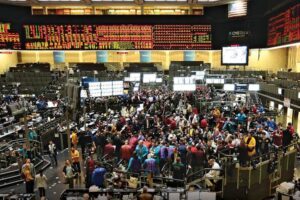At the close on Wednesday, the Dow Jones Index (US30) fell by 0.04%. The S&P 500 Index (US500) rose by 0.40%. The Technological Nasdaq Index (US100) closed higher by 0.66%. US stocks finished a volatile session on Wednesday mostly higher, despite lingering trade tensions between the US and China and a protracted government shutdown. Morgan Stanley shares hit a record high, climbing by 4.7%, and Bank of America rose by 4.4% after both banks exceeded third-quarter profit expectations due to robust deal-making.
In mid-October, the Canadian dollar depreciated to a six-month low, falling to 1.4 per US dollar, influenced by declining oil prices, slowing domestic data growth, and expectations of Bank of Canada interest rate cuts. Oil prices, Canada’s largest export, dropped to a five-month low amid persistent US-China trade tensions, rising supply, and an expected increase in US inventories, fueling fears of oversupply and weakening demand, and stripping the currency of key support.
European indices traded mixed on Wednesday. Germany’s DAX (DE40) fell by 0.23%, France’s CAC 40 (FR40) closed with a gain of 1.99%, Spain’s IBEX35 Index (ES35) dropped by 0.10%, and the UK’s FTSE 100 (UK100) closed negative 0.30%. Industrial production in the Eurozone contracted by 1.2% in August 2025 compared to the previous month, a reversal from the upwardly revised 0.5% growth in July, and slightly exceeding market expectations, which had predicted a 1.6% drop. Sweden’s annual inflation rate fell to 0.9% in September 2025 from a six-month high of 1.1% in August, confirming preliminary estimates and remaining below the 2% target set by the Riksbank. Meanwhile, the CPI with a fixed interest rate (CPIF) – the Riksbank’s preferred measure of inflation – rose to 3.1% year-on-year in September, slightly easing from the 3.2% growth in August, which was the highest since January 2024.
WTI crude oil prices fell by 0.7% to reach $58.3 a barrel on Wednesday, extending losses for a second day and hovering near a five-month low, as persistent US-China trade tensions and increasing supply concerns weigh on sentiment. The International Energy Agency warned that the global oil market could see a surplus of up to 4 million barrels per day in 2026, intensifying worries about sluggish demand. Expectations of another weekly rise in US crude oil inventories amplified signs of oversupply, which could mark the third consecutive week of inventory growth. Traders are now awaiting official US inventory data for clearer demand signals as the market continues to absorb returning OPEC+ production.
Asian markets were mostly higher yesterday. Japan’s Nikkei 225 (JP225) rose by 1.76%, China’s FTSE China A50 (CHA50) gained 1.77%, Hong Kong’s Hang Seng (HK50) rose by 1.84%, and Australia’s ASX 200 (AU200) showed a positive result of 1.03%.
The Australian dollar weakened below $0.650 on Thursday, reversing the previous session’s gains, after a weaker employment report revived expectations of an RBA rate cut. The Australian Bureau of Statistics reported that the unemployment rate rose more than expected to 4.5%, the highest level in almost four years, while employment increased by only 14,900 people, falling short of the 20,000 prognosis. This data signals a further softening of the labor market, strengthening bets that the Reserve Bank (RBA) may resume cutting rates as early as next month. Investors now price in a 71% chance of policy easing, compared to 40% before the data release. Attention now turns to third-quarter inflation data.









